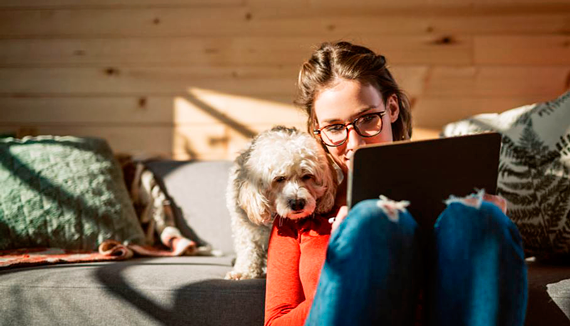
Pet owners are being warned that their dogs could develop separation anxiety once the coronavirus lockdown ends, having become accustomed to extra human attention while their owners are at home.
Burns Pet Nutrition, founded by veterinary surgeon John Burns, has warned dog owners that their pets are at risk of suffering from anxiety problems when they finally go back to work, unless steps are put in place to prepare them.
The company is urging owners to take action now to help pets get ready for the return to normality and prevent them from developing attachment issues post-lockdown.
Burns is advising owners to spend some time away from their dogs during the day, even while in the same house, to ensure they get used to time alone so that it won’t come as a shock once the lockdown is lifted.
Such measures will be particularly important for the thousands of pets that have been bought or adopted during the pandemic, especially puppies, as they will have only ever experienced life in lockdown and may not yet have been separated from their owners.
The warning comes as demand for pets over the lockdown period has surged, with the Kennel Club seeing searches for puppies rise by 53% and rescue centres reporting a significant increase in adoption interest.
DREAM COME TRUE
Ben Evans, dog trainer, owner of Dog Behaviour Wales and an advisor to Burns, said: “Many dog owners across the country will have been enjoying spending extra time with their pets over the lockdown, but while this newfound time together will have been a dream come true for dogs, it could cause problems down the line.
“After being used to having us around 24/7, it may be difficult for our dogs to cope when we go back to our regular routines and aren’t around all the time, especially for puppies who know no different. It’s imperative that owners take precautions to prevent pets from becoming unnecessarily distressed once the lockdown ends.”
Dogs with separation anxiety are generally distressed when left alone, experiencing symptoms including excessive barking and howling, urination and defecation, destructive behaviours, salivation and pacing.
Ben said: “Owners need to normalise the fact that being alone is not a big deal by doing plenty of it in short bursts. Start off with just 10-15 seconds, gradually building this up to minutes and eventually a couple of hours. Leaving and returning should be relatively uneventful as animated greetings or goodbyes can build up anticipation or anxiety.
DESENSITISE
“It’s also important to desensitise dogs to any signs that indicate you are about to leave. Try picking up and putting down car keys throughout the day, opening and closing doors without leaving, picking up and moving shoes and bags, or putting on a coat and walking around with it before removing it. All these steps will help to prevent these possible triggers from causing anxiety.”
As well as ensuring dogs have controlled periods alone, they should be given something to do to help reduce their anxiety when left alone. Burns recommends using food to keep them distracted and help them develop positive associations with being alone.
Laura Crotch-Harvey, nutrition manager at Burns, said: “Using enrichment toys such as Kongs, lick mats, slow feeders and appropriate chew toys help to keep dogs occupied while you are gone. Using your dog’s meal as the filler and hiding healthy extras in there such as vegetables, cooked chicken or peanut butter, will make your dog enthusiastic for the fun activity ahead.
“Combining these activities with alone time will not only act as a pacifier but will build on the positive association that good things happen when they are left alone.”


